Today we are going to review a cheap and popular phone: the Nokia C2-01. It actually deserves some praise for squeezing some goodies into its budget, such as 3G, 3.2MP still imaging and a hotswappable microSD card slot.
The Nokia C2-01 comes in a thin cardboard box (Pic. 1). As well the phone itself, you’ll find a wall charger and a one-piece headset there (Pic. 2). As a tradition, we tested the two handsets of this model (Pic. 3–5).
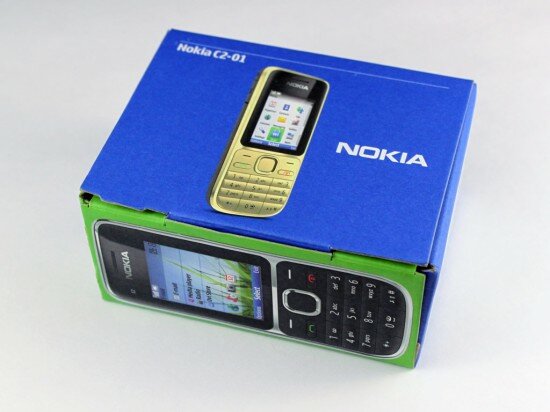
Pic. 1. Package box

Pic. 2. Accessories
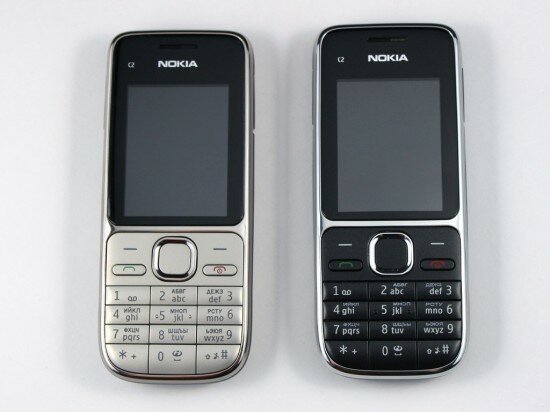
Pic. 3. The Nokia C2-01 from the front
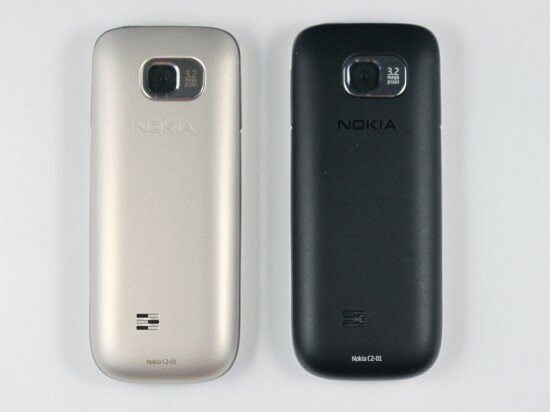
Pic. 4. Back side of the Nokia C2-01

Pic. 5. Middle edge of the Nokia C2-01
The Nokia C2-01’s stress tests (the 1st handset)
1. Reception quality
First of all we checked how the Nokia C2-01 is good at receiving calls. We used a plain cardboard box, applied glue all over it and pasted aluminum foil rectangles over all the surfaces of the box. Then we cut a slot into the top of the lid and put the phone inside the box through this slot. This conditions can definitely have an effect on the reception, making it weaker. At last we started calling to the phone.
Actually we used 3 lids with different slot dimensions: 45 mm by 50 mm (1.57-inch by 1.97-inch), 20 mm by 20 mm (0.787-inch by 0.787-inch) and 15 mm by 15 mm (0.59-inch by 0.59-inch) (video 1 – 3). The signal can be received only through these slots. We made 3 series of calls depending on the lid we chose.
All the incoming calls were successfully received by the phone at the beginning. But when we used a lid with the average slot dimensions (20 mm by 20 mm) the reception became worse. In fact, the signal indicator displayed only 1 bar. One of our calls wasn’t received at all. We were informed that the subscriber was “busy”. It happened because the phone was switching between 3G and GSM. That is why the subscriber wasn’t available at that moment.
When we used the lid with the smallest slot dimensions 3 out of 10 calls went directly to “dead air”.
Video 1. Reception quality (stage 1)
Video 2. Reception quality (stage 2)
Video 3. Reception quality (stage 3)
Grade (stage 1): 3 (with 3 being the highest possible grade)
Grade (stage 2): 2 (with 3 being the highest possible grade)
Grade (stage 3): 2 (with 3 being the highest possible grade)
2. Freeze test
In this test we chilled the Nokia C2-01 in the fridge for about 2.5 hours. The temperature was -15 °С (5 °F). We just wanted to know how this phone works in cold weather. We put it in standby mode (screen off) and placed it in the fridge. In 2 hours we started calling to the phone and it rang.
When the time of the test was over we took it out for examination (video 4). The battery was almost full, though it should deplete much faster in cold weather. The display malfunctioned but we could live with it. The keys became stiff. The phone vibrated louder than it used to do. It was a real bug.
Fortunately, all the problems were solved when we warmed the phone. As for the grade, we hesitated between 2 and 3 but decided to put 3 because the battery stayed full.
Video 4. Here’s how the phone looks like after the freeze test.
Grade: 3 (with 3 being the highest possible grade)
3. Short circuit of the battery charger
This time, we tested the wall charger. Connected its terminals for a second thus producing a short circuit (video 5). The charger stayed absolutely functional.
Video 5. Short circuit of the battery charger
Grade: 3 (with 3 being the highest possible grade)
4. Short circuit of the battery
Next, we shorted the Nokia C2-01’s rechargeable battery and it survived. In fact, all lithium-ion batteries are not resistant to short circuits. But in mobile phones batteries contain special elements that protect them from short circuits.
Video 6. Short circuit of the battery
Grade: 3 (with 3 being the highest possible grade)
5. Charging the phone with extremely high and low voltage
Now let’s see the phone’s reaction to different rates of charging. We used a regulated power supply that was plugged into the outlet. Then we plugged one end of the cable of the charger into the regulated power supply. The other end of the cable was plugged into the charger jack of the Nokia C2-01. With the help of the regulated power supply we were able to control the rate of charging. We could increase or decrease it as we wished (video 7).
At first, we slowly turned the charging rate up to 8 V. The phone’s current consumption increased to 1.15 A. It is disastrous for the innards and can reduce battery capacity. Despite this, the phone continued consuming the current and fortunately survived. Next, we turned the charging rate as down as possible making it much less than normal. The phone warned us about the absence of charging. So we turned it up to a normal rate. However, there was no charging anyway. In order to solve this problem we unplugged the charger out of the phone and plugged it again. The phone started charging.
Video 7. Charging the phone at a higher rate
Grade: 2 (with 3 being the highest possible grade)
6. Providing the phone with extremely high power
Finally, we provided the phone with extremely high voltage (video 8). This test is far from real life situations but it shows how the phone performs with extremely high or low power provided. We lifted the battery out of its compartment and connected the regulated power supply into the phone directly. Then we tried to turn the power rate up from 4 V to 7 V.
At the beginning of the experiment everything was fine. The phone consumed 10 mA of power which is normal. But when we reached 6.6 V the current consumption was raised to 1.5 A. It switched the phone off. Evidently, some of the elements were damaged. However, we managed to turn on the phone and it worked, unfortunately not as fine as before. It consumed a lot of power in standby mode. A great amount of current made the phone too hot to use. Moreover, the battery started to deplete much faster than before (in a few hours it was empty). Anyway, the handset was still eligible for the other tests.
Video 8. Providing the phone with extremely high power
Grade: 2 (with 3 being the highest possible grade)
7. Leaving the cell phone out in the rain
Water attack is one of the commonest reasons of cell phone damage. That is why we prepared 4 water tests for the Nokia C2-01.
At first, we simulated a situation when a person leaves his/her cell phone out in the rain (video 9). We put the handset under low-flow shower for 1 minute. At the very start of the test, the display back light was turned on by the drops of water that penetrated inside the phone and reached its electronic elements. After this test we heard some noise from the speaker (the speaker grille cloth got wet). This noise disappeared as soon as the grille cloth became dry. The connectors on the middle edge of the phone were filled with water (Pic. 6). But the USB port stayed dry due to its cap. The battery was also wet. We even saw drops of water under it (Pic. 7). The phone stayed absolutely functional, though.
Video 9. Leaving the cell phone out in the rain
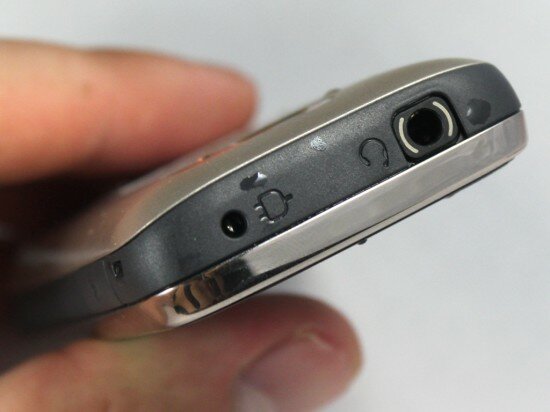
Pic.6. Drops of water in the charger and headphone jacks
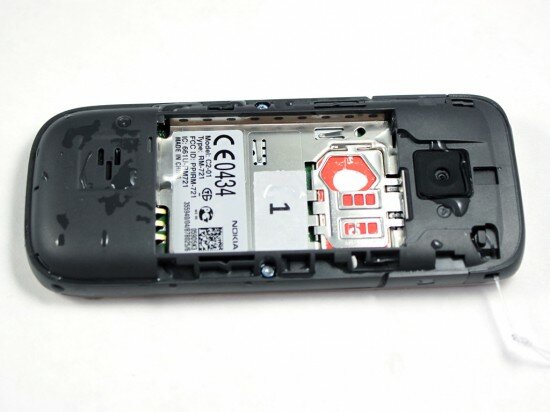
Pic.7. Drops of water in the battery compartment
Grade: 3 (with 3 being the highest possible grade)
8. The Nokia C2-01’s submerge to a shallow depth
In this test we submerged the phone to a shallow depth for 20 seconds (video 10). The handset showed better result compared to the previous water test. We saw fewer drops of water on the battery and there was no water under it. The compartment was almost dry. As for the other parts of the phone, the result is pretty much the same.
Video 10. The Nokia C2-01’s submerge
Grade: 3 (with 3 being the highest possible grade)
9. The Nokia C2-01’s submerge to a depth of one meter (3.28 feet) for 20 seconds
This time we decided to drop the handset in a pond rather than in a puddle. In fact, we placed the phone in a 1m length pipe (3.28 feet) filled with water (video 11). The phone had already switched itself off by the time it reached the bottom of the pipe. A great pressure allowed water to penetrate inside the handset and turn it off. When we took it out for examination we noticed that water penetrated under the screen glass.
According to the rules that we established by ourselves, we were not permitted to disassemble the handset in order to dry it out. So we could only take off the back cover and lift the battery out. We dried the Nokia for a whole day and fortunately the water spots under the screen glass disappeared. Moreover, we turned on the phone and it worked pretty fine. The picture on the screen was all right.
Video 11. The Nokia C2-01’s submerge to a depth of 100 cm (3.28 feet)
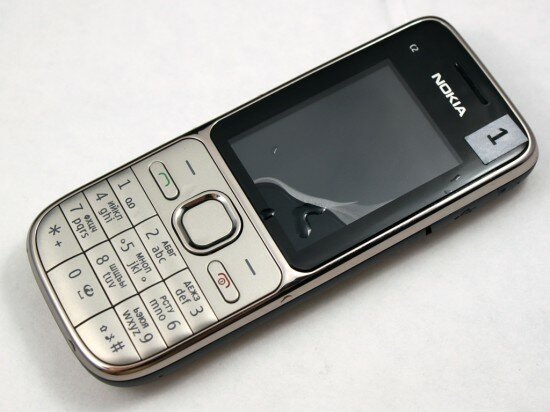
Pic. 8. Drops of water under the screen glass
Grade: 2 (with 3 being the highest possible grade)
10. Submerge to a depth of one meter for 30 minutes
Only IPx1-IPx6 waterproof cell phones are eligible for this test.
Grade: –
11. Submerge to a depth of two meters
Only IPx7 waterproof cell phones are eligible for this test.
Grade: –
12. Immersion in beer
Actually this is not a water test, because we used beer instead of distilled water. Beer is a very popular alcoholic drink in the world and sometimes people drop their handsets in glasses of beer or spilt beer on their mobile phones. Such incidents may have a great effect on electronic elements of the phone which may result in corrosion.
In this test we dunked the Nokia C2-01 under beer for 10 seconds. This experiment proved that beer penetrates deeper and faster inside the phone than water. We saw many more drops of beer in the battery compartment compared to the results of the water tests. In a minute after this experiment, we saw a steam condensate under the screen glass. It means that some beer penetrated under the screen.
We washed the phone a little bit and dried it out. It worked pretty fine afterwards.
Video 12. Immersion in beer

Pic. 9. Steam condensate inside the screen glass
Grade: 3 (with 3 being the highest possible grade)
13. Disassembling. Build quality
All the stress tests of the first handset are over. We disassembled the Nokia C2-01 (Pic. 10). It was easy because we had to remove only 6 screws. So let’s have look inside the phone.
The display and the D-pad are attached to a plain circuit board (Pic. 11) with the help of a steel band. The processor is protected buy the steel non-removable shield. The antenna is placed in the lower part of the casing. This design is not fine, though very widespread.
All in all, the Nokia C2-01’s design and build quality are quite in line with its budget.
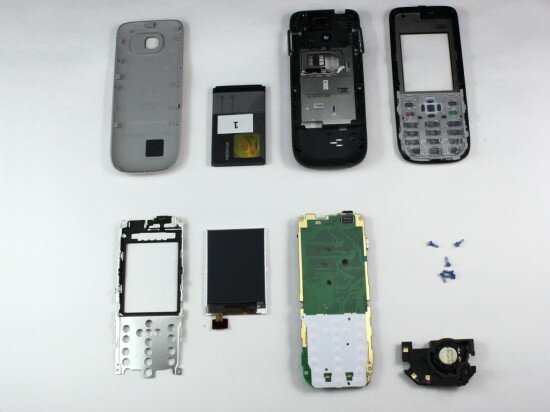
Pic.10. Here’s how the Nokia C2-01 looks like when disassembled
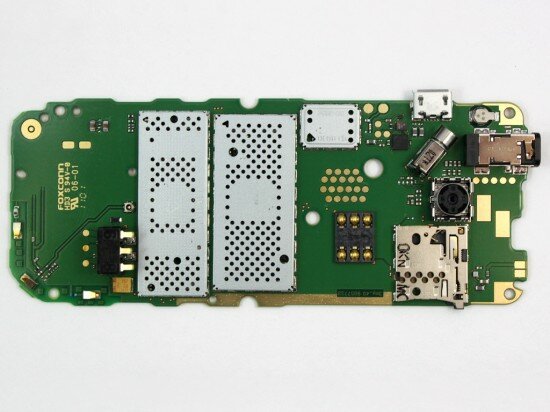
Pic.11. Circuit board
Grade: 3 (with 3 being the highest possible grade)
14. Headphone cable testing (bending)
Any time you use your headphones you bend their cable to some extent. Sooner or later your headphones will be shorted out by a break in the wire. So you can’t listen to your favourite music any more. Most often, headphones short out where the wire connects to the part that plugs into the headphone jack, or, where the wire connects to the speakers.
In this test we used a machine that was devised specially for bending such things as headphone cables (Pic. 13). The whole test was divided into 3 stages: 1000, 1500 and 2000 bends. We examined the state of the headphones after every stage. The headphones showed very good results. They worked with no problem afterwards.
Video 13. Bending the headphone cable
Grade (stage 1): 3 (with 3 being the highest possible grade)
Grade (stage 2): 3 (with 3 being the highest possible grade)
Grade (stage 3): 3 (with 3 being the highest possible grade)
15. Headphone cable testing (static loads)
We prepared another test for the headphones. This time we tried to break the wire by straining it. Actually we pulled the cable like a string and hung the three loads on it like people hang their clothes on the clothesline (video 14). Each of the loads weighed 1 kg (2.2 lbs). As a result, there were no shorts. The headphones worked perfectly.
Video 14. Headphone cable testing (static loads)
Grade (stage 1): 3 (with 3 being the highest possible grade)
Grade (stage 2): 3 (with 3 being the highest possible grade)
Grade (stage 3): 3 (with 3 being the highest possible grade)
The Nokia C2-01’s stress tests (the 2nd handset)
1. Cell phone’s reception
The second phone of the Nokia C2-01 model passed the reception test too. The conditions were absolutely the same as in the first case.
At the begging, the phone showed fine results. When the dimensions of the slot were 20 mm by 20 mm (0.787-inch by 0.787-inch) all of the 10 incoming calls were received. If you remember, the first handset received only nine calls in the same conditions.
The slot, measured 15 mm by 15 mm (0.59-inch by 0.59-inch) allowed the phone to receive only 8 calls. This handset was also switching between 3G and GSM and that was the problem.
Grade (stage 1): 3 (with 3 being the highest possible grade)
Grade (stage 2): 3 (with 3 being the highest possible grade)
Grade (stage 3): 2 (with 3 being the highest possible grade)
2. Talk time
Despite the phone has a powerful battery (1020 mAh), the talk time is relatively short:
- 8 hours and 45 minutes (GSM)
- 4 hours and 30 minutes (3G)
In order to check the Nokia C2-01’s talk time we performed the following test: charged the battery, switched the phone to 3G, dialed a number and left the phone in speaking mode. Once in an hour we had to dial again because mobile operators don’t allow to speak on the phone for more than an hour.
In 5 hours and 15 minutes the phone gave a warning that the battery was empty and switched itself off. So the Nokia C2-01 has even longer 3G talk time than the manufacturer claims. But mind that if you need only voice calls, you’d better switch your phone to GSM. It saves your battery life time and doubles your talk time.
Grade: 3 (with 3 being the highest possible grade)
3. Drops on the carpet
Drop test is an integral part of any stress test. Everyone drops his/her phone sooner or later. All the manufacturers know it and try to make their products as rigid as possible. So the handsets go through a lot of tests before they are put on sale. One of such tests are drops from different heights.
We performed our own experiment. The Nokia C2-01 (the second handset) was dropped on the carpet with each face, edge and corner from 100 cm (3.28 ft), 150 cm (4.9 ft) and 200 cm (6.56 ft). Check out the videos (15 – 17).
The phone sustained no damage till we started to drop it from 200 cm (6.56 ft) when the front panel separated from the casing. Fortunately it happened only for one time and nothing was broken. We put it back and the phone performed with no problem.
Video 15. Drops on the carpet from 100 cm (3.28 ft)
Video 16. Drops on the carpet from 150 cm (4.9 ft)
Video 17. Drops on the carpet from 200 cm (6.56 ft)
Grade (stage 1): 3 (with 3 being the highest possible grade)
Grade (stage 2): 3 (with 3 being the highest possible grade)
Grade (stage 3): 3 (with 3 being the highest possible grade)
4. Drops on a tile
In this test, we dropped the handset on a tile but the heights were smaller: 30 cm (11.8 inches), 50 cm (1.64 ft) and 100 cm (3.28 ft). Check out the videos (18 – 20). Like in the previous test the phone showed good results at the beginning. But when we dropped it from 1 m (3.28 ft) the back cover fell off and the front panel separated from the case but we put them all back.
When we examined the phone we noticed some scuffs near the corners (Pic. 12). But the handset worked fine anyway. The Alcatel OT-606 showed the same damage after the same test. We told you about this handset in the previous review .
Video 18. Drops on the tile from 30 cm (11.8 inches)
Video 19. Drops on the tile from 50 cm (1.64 ft)
Video 20. Drops on the tile from 100 cm (3.28 ft)
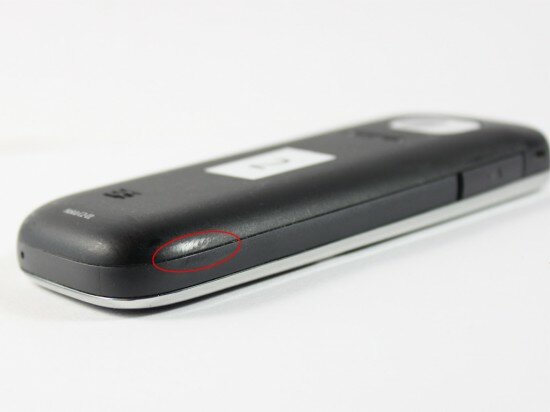
Pic.12. Scuffs on the phone
Grade (stage 1): 3 (with 3 being the highest possible grade)
Grade (stage 2): 3 (with 3 being the highest possible grade)
Grade (stage 3): 2 (with 3 being the highest possible grade)
5. Crushing the phone with a wooden bar
This experiment will show what can happen to the Nokia C2-01 if a person accidentally sits or steps on it. Actually we placed a wooden bar on the phone and applied some pressure above the bar. At first we applied 5 kg (11 lbs), then 20 kg (44 lbs) and 50 kg (110 lbs). As a result, there was no visible damage on the phone’s body, though the battery sustained two tiny dents.
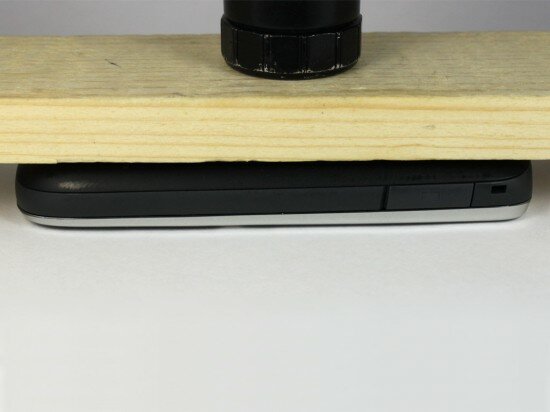
Pic. 13. Crushing the phone with a wooden bar
Grade (stage 1): 3 (with 3 being the highest possible grade)
Grade (stage 2): 3 (with 3 being the highest possible grade)
Grade (stage 3): 3 (with 3 being the highest possible grade)
6. Breaking the cell phone in half (bending)
Essentially, bending and crushing are very close to each other. The only difference lies in the way how we apply pressure on the phone. If you want to break your handset into two parts or at least make some bend you should apply power at a particular point of the casing (somewhere in the middle).
So we did the following: put the Nokia C2-01 onto the two planks so that each edge of the handset lay on a single plank. Then we hitched a string with a load on top of the device. At first we used a 3 kg (6.6 lbs) pressure. The result: no bend. But we went further and applied 7 kgs (15.4 lbs). The result: very little bend. A last, we applied 15 kgs (33 lbs) and there was quite a visible bend (Pic. 14). The phone stayed functional after this test.

Pic. 14. Here’s how the phone looked like when we applied 15 kg (33 lbs)
Grade (stage 1): 3 (with 3 being the highest possible grade)
Grade (stage 2): 3 (with 3 being the highest possible grade)
Grade (stage 3): 3 (with 3 being the highest possible grade)
7. Keyboard
The main disadvantage of the keypad is the big gaps between the keys that may be filled with dust, grime and sand. All the 12 keys of the keypad are flat. They are not always comfortable to use because of a slightly convex shape. The chrome-effect band around the unit may be scuffed very soon if you put the phone with its face down very often.
Grade: 2 (with 3 being the highest possible grade)
8. Dust test
If you don’t disassemble and clean your phone for a long tine you’ll risk to have a lot of dust inside it. It doesn’t matter how you use your handset. Keeping your phone in a pocket won’t save it from dust. Don’t worry, your handset will work even if dust penetrates deep inside the casing. However, sometimes dust has a negative effect on the connectors and keypad. Dust may also ruin the picture on screen if it penetrates under the glass.
In order to check the Nokia C2-01’s dust resistance we threw the phone inside an enclosed tray containing dust and made it vibrate viciously for some time (video 21). The whole test was divided into periods: 1, 3 and 6 minutes. We checked the state of the handset after every period of the experiment.
When we examined the phone for the first time there were no serious problems. We saw a few small grains of dust in the USB port (Pic. 15). The battery and its compartment were clean too (Pic. 16).
In 3 minutes we took out the phone again and heard some noise when pressed the keys. The gaps between them were filled with dust (Pic. 17). We managed to get rid of it by slapping the handset with our hands. As for the rest, the Nokia C2-01 showed fine results.
The more time the phone spent in the drum the more dust we saw under the back cover and in the connectors (Pic. 18). After the last period of the experiment all the 12 keys became stiff. We heard the noise again when we pressed them. We cleaned the keypad and everything became OK.
Video 22. Dust test
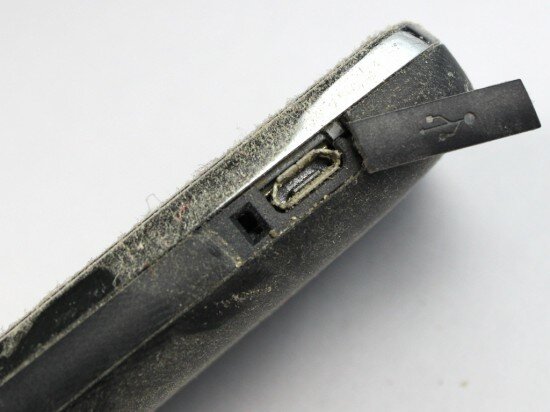
Pic.15. Dust in the USB port after 1 minute of the test
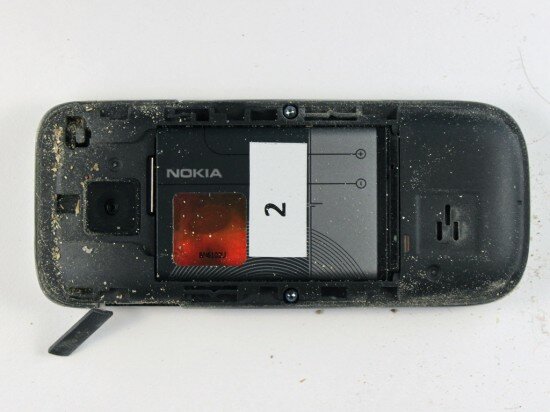
Pic.16. Dust under the back cover after 1 minute of the test
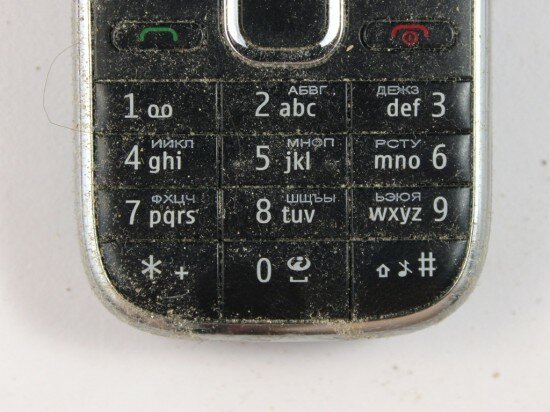
Pic.17. Here’s how the keypad looked like after the second period of the experiment
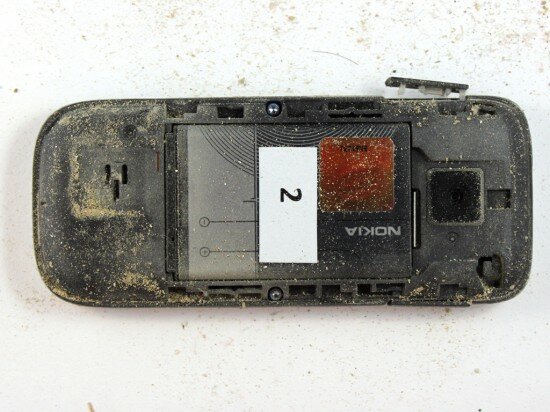
Pic. 18. Dust under the back cover after the third period of the experiment
Grade (stage 1): 3 (with 3 being the highest possible grade)
Grade (stage 2): 3 (with 3 being the highest possible grade)
Grade (stage 3): 2 (with 3 being the highest possible grade)
9. Durability test
This test is a good example of a situation when a phone is accidentally rubbed against a rough surface (video 22). This test was also divided into periods: 5, 10 and 15 minutes. The Nokia C2-01 showed no visible damage after this test.
Video 23. Durability test
Grade (stage 1): 3 (with 3 being the highest possible grade)
Grade (stage 2): 3 (with 3 being the highest possible grade)
Grade (stage 3): 3 (with 3 being the highest possible grade)
10. Simulation of carrying the phone in a pocket
Would you like to know how your Nokia C2-01 will look like after some months of use and even abuse? It’s quite easy. In order to make it look older we placed the gadget inside a drum together with keys, pennies, and plastic balls to simulate what might be happening in a man’s pants pockets while carrying the phone (video 23). We also divided this experiment into three periods: 5, 10 and 15 minutes and examined our device every time.
You know, the chrome-effect band around the phone was never considered durable. As a result, it was completely scuffed in some areas (Pic. 19). We can also infer that the phone is made of a low quality plastic because the back cover was scratched all over (Pic. 20). This is an outcome only of the 5 minute test. The further, the worse…
After the second period of the experiment we saw many more scratches on the corners and on the back cover (Pic. 21). There were also some small scuffs on the screen. Check out picture 22 to see how the back cover looked like after the whole test. We saw the scuffs all over the chrome-effect band. On the corners the paint was scuffed so much that we could see the plastic casing (Pic. 23). However, if you compare the Nokia C2-01 and the Nokia 2700 after this test you’ll understand that the C2-01 is more durable and rugged. The screen glass is nothing to talk about much. It only sustained some tiny scuffs and scratches and showed the same results as the other budget phones’ screens.
Video 23. Simulation of carrying the phone in a pocket
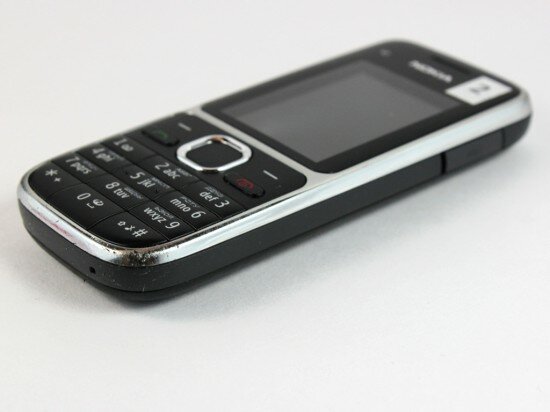
Pic. 19. Here’s how the corners of the phone looked like after the first period of the test
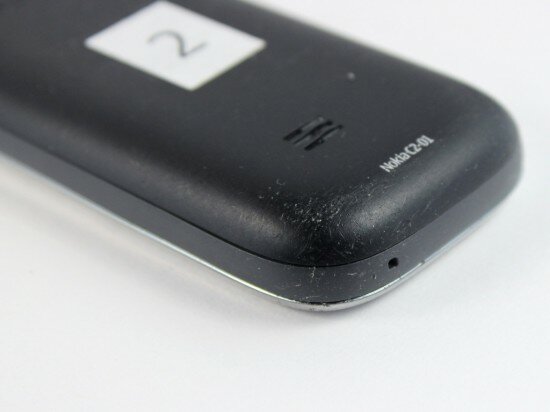
Pic. 20. Here’s how the back cover looked like after the first period of the test
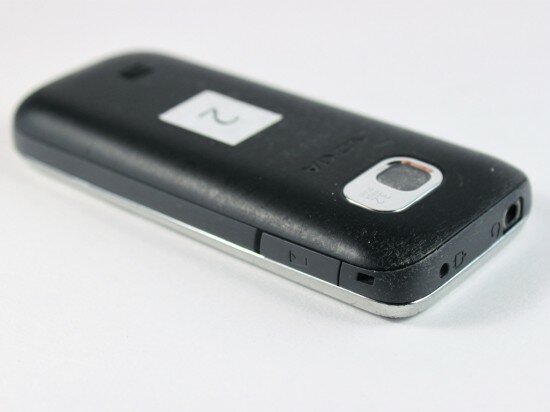
Pic.21. Here’s how the middle edge of the phone looked like after the second period of the test

Pic. 22. Damage of the back cover after the whole test
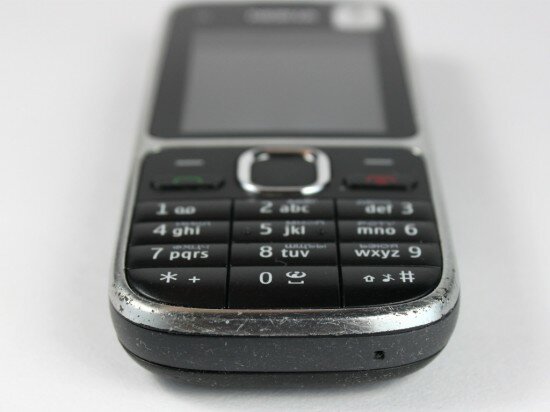
Pic. 23. Here’s how the chrome-effect band looked like after the whole test
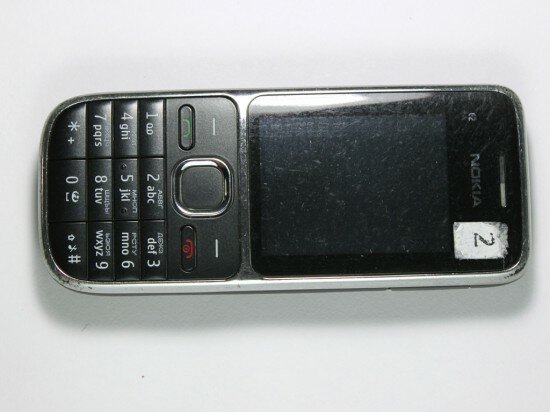
Pic. 24. The screen (after the whole test)
Grade (stage 1): 2 (with 3 being the highest possible grade)
Grade (stage 2): 2 (with 3 being the highest possible grade)
Grade (stage 3): 2 (with 3 being the highest possible grade)
11. Scratch resistance of the screen
In order to check the Nokia C2-01’s scratch resistance we scratched the back cover and the screen with a nail that was locked in a machine, specially devised for this test. This machine put pressure above the nail and we could regulate it. Then we ran the phone over the sharp tip of the nail. The test was divided into three stages according to the force of pressure on the nail: 100 g (0.22 lbs), 300 g (0.66 lbs) and 600 g (1.3 lbs) (video 24 – 26).
All in all, we made 3 scratches. The first (when the pressure on the nail was 100 g) was so tiny that we hardly even saw it. The second scratch was visible but not very deep. When we applied 600 g (1.3 lbs) the nail produced a large scratch that was quite deep (Pic. 25). The first scratch was visible only when the image on the screen was white (Pic. 26). But the second and the third scratches struck our eyes really.
Video 24. Scratching the screen at the force of 100 g (0.22 lbs)
Video 25. Scratching the screen at the force of 300 (0.66 lbs)
Video 26. Scratching the screen at the force of 600 (1.3 lbs)
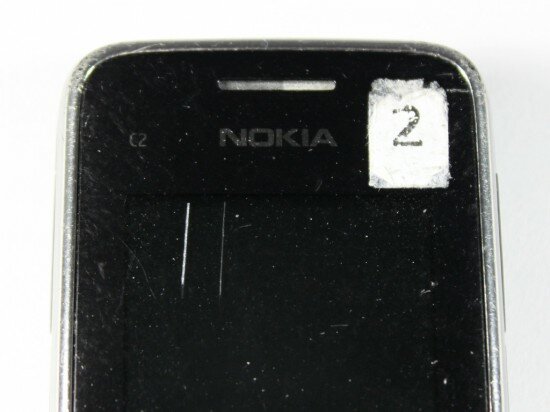
Pic. 25. Scratches on the screen
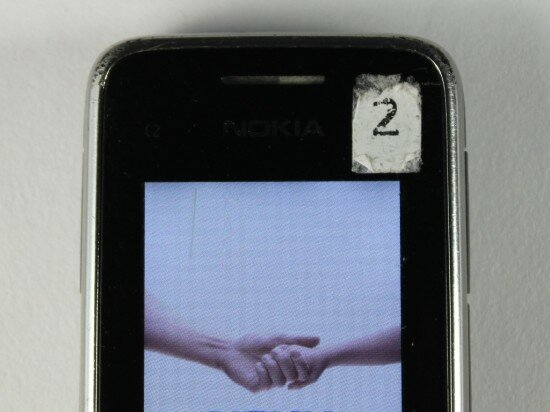
Pic. 26. Here’s how the screen looks like when the image is white
Grade (stage 1): 3 (with 3 being the highest possible grade)
Grade (stage 2): 2 (with 3 being the highest possible grade)
Grade (stage 3): 2 (with 3 being the highest possible grade)
12. Scratch resistance of the back panel
The back cover was scratched the same way as the screen. As we said before, the phone is made of a low quality plastic. So we made three visible scratches (Pic. 27, video 27 – 29).
Video 27. Scratching the back panel at the force of 100 g (0.22 lbs)
Video 28. Scratching the back panel at the force of 300 (0.66 lbs)
Video 29. Scratching the back panel at the force of 600 (1.3 lbs)
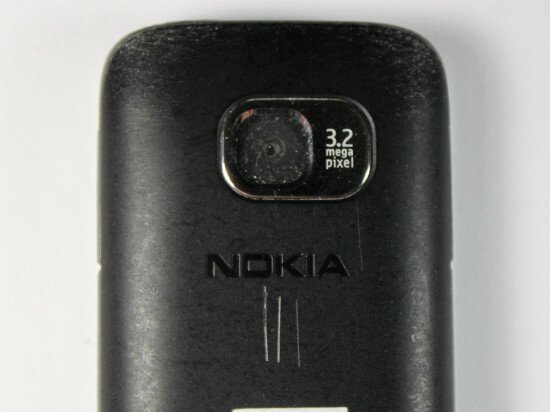
Pic. 27. Scratches on the back panel
Grade (stage 1): 2 (with 3 being the highest possible grade)
Grade (stage 2): 2 (with 3 being the highest possible grade)
Grade (stage 3): 2 (with 3 being the highest possible grade)
13. Test of the screen glass
In this test we found out whether the Nokia C2-01’s screen glass is rugged or not. We dropped a steel ball on it for 3 times: from 10 cm (3.9 inches), 15 cm (5.9 inches) and 25 cm (9.8 inches) (video 30). The diameter of the ball is 22 mm (0.86 inches).
The screen survived all the strikes of the ball, though we saw some small scuffs after the test (Pic. 28). However, there were no cracks and the screen looked still nice when the phone was turned on.
Video 31. Test of the screen glass
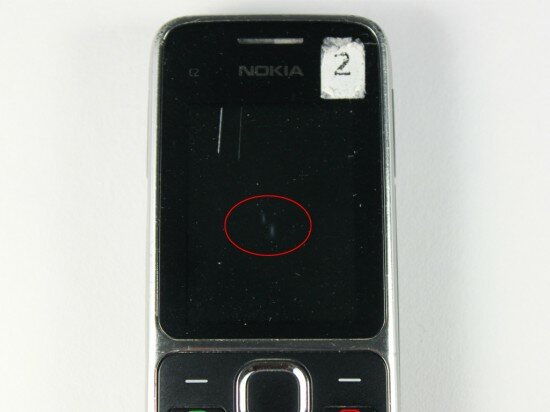
Pic. 28. Scuffs on the screen
Grade (stage 1): 3 (with 3 being the highest possible grade)
Grade (stage 2): 3 (with 3 being the highest possible grade)
Grade (stage 3): 3 (with 3 being the highest possible grade)
14. Heat test
We performed the freeze test of the first handset of the Nokia C2-01. But for the second phone we prepared quite an opposite test – the heat test. We placed the gadget and the light bulb (40 Wt) in a small can so that the distance between the phone and the lamp was approximately 5 cm. Then we switched on the lamp and it heated the handset for three periods of time: 3, 5 and 10 minutes (video 31 – 33). We examined the phone after every period.
The Nokia C2-01 sustained no damage after the two periods of heating. The temperature of the phone was only 98 °С (208.4 °F) which is not too high. But when we heated it for 10 minutes the screen became dim and the glass melted. The temperature rose to 118 °С (244.4 °F). Fortunately, the screen got better as the phone was chilling.
Video 31. Heating for 3 minutes
Video 32. Heating for 5 minutes
Video 33. Heating for 10 minutes
Grade (stage 1): 3 (with 3 being the highest possible grade)
Grade (stage 2): 3 (with 3 being the highest possible grade)
Grade (stage 3): 2 (with 3 being the highest possible grade)
15. Smashing the phone
We have done a lot of tough stress tests and going to show you the last and, probably, the toughest one. We decided to smash the Nokia C2-01. How? We dropped it on a tile for many times from 150 cm (4.9 ft) at first. As a result, the back cover fell off constantly and the front panel separated from the casing all the time. But the handset stayed functional and didn’t even sustain any visible damage.
But we went further and increased the height of the drops to 200 cm (6.56 ft). Finally, we reached our aim – the display was broken. It became absolutely dim and showed some cracks. The phone didn’t function any more.
Video 34. Drops on the tile from 150 cm (4.9 ft)
Video 35. Drops on the tile from 200 cm (6.56 ft)
Grade (stage 1): 3 (with 3 being the highest possible grade)
Grade (stage 2): 1 (with 3 being the highest possible grade
16. Disassembling. Build quality
As you guess, both handsets were disassembled after the stress tests. Their build quality is fine. We didn’t notice any defects.
We think that the screen of the second handset was broken because it is removable. If it had been soldered to the circuit board like in more expensive cell phones, this wouldn’t have happened.
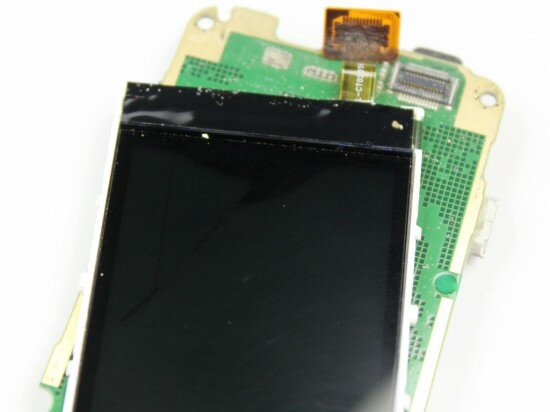
Pic. 29. Damage of the display
Grade: 2 (with 3 being the highest possible grade)
All in all, the Nokia C2-01 gains 615 points (with 702 being the highest possible grade)
Final words
In some tests he Nokia C2-01 showed average results, in some – it was even worse than the other budget phones. In the end, we had two damaged handsets. The first depletes the battery in a few hours in standby mode. The other one got lots of scuffs and scratches, has a melted screen glass and a broken display.
The result, shown by the Nokia is similar to what we saw in the previous review . In some tests the Alcatel OT-606 showed even better results than the Nokia. For example, the C2-01 sustained more serious damage during the drops on the tile. Both the Nokia and the Alcatel malfunctioned when we provided them with too much power. But the Alcatel OT-606 stayed functional after this test while the Nokia C2-01 needs repairing.
We shouldn’t also forget that reception is not a strong point of the Nokia C2-01 .
Video 38. Here’s how both handsets look like after all the stress tests
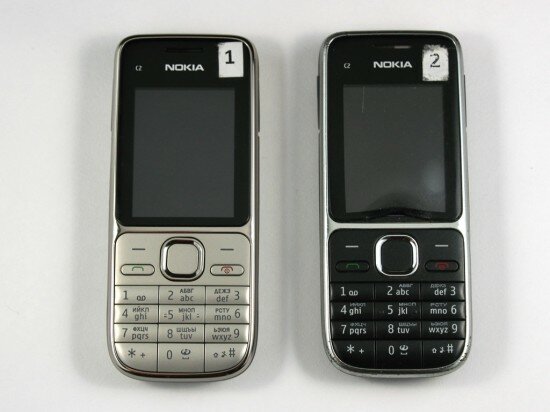
Pic. 30. The front side

Pic.31. The back side
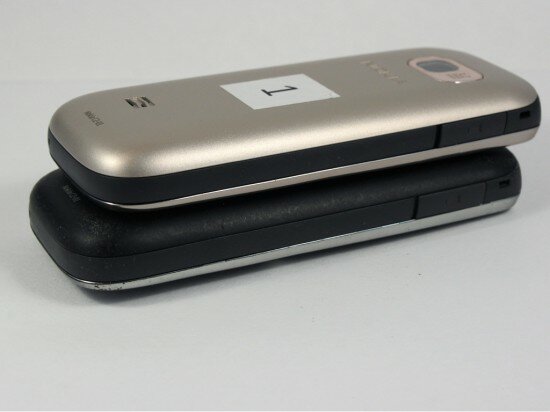
Pic 32. Side view
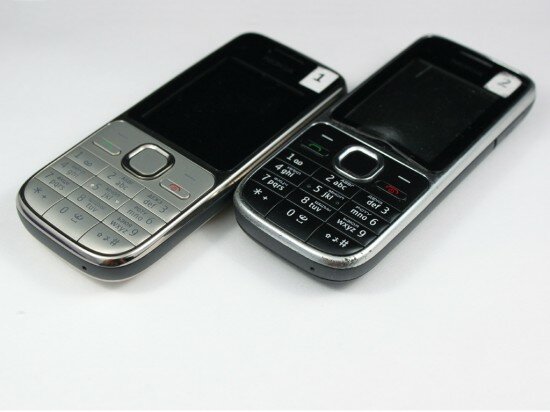
Pic 33. Here’s how the corners of the handsets look like

 Russian version
Russian version